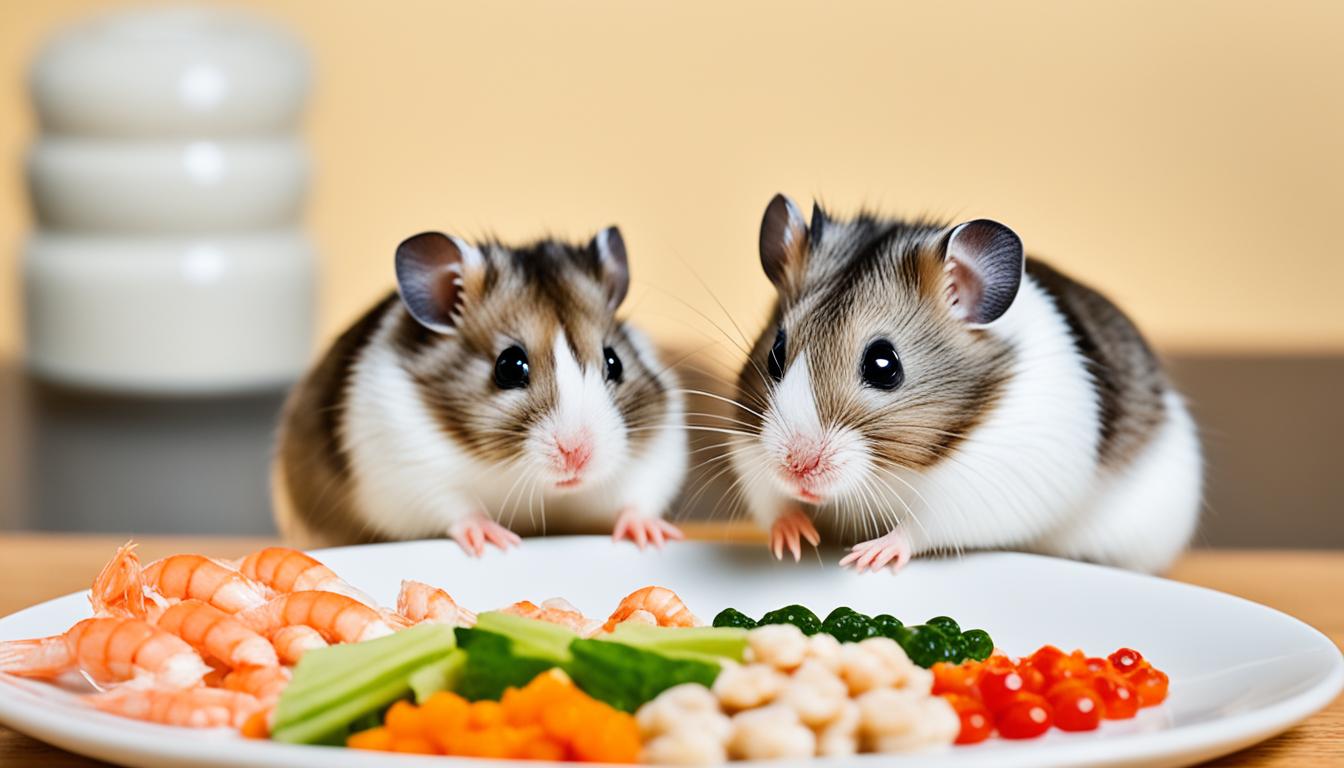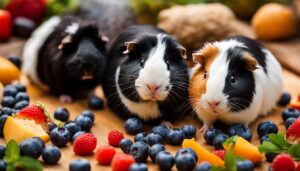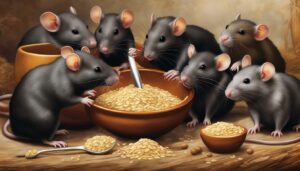Hamsters are small, cute pets that can be quite affectionate. In the wild, they are omnivores, meaning they eat both plants and insects.
When it comes to their diet in captivity, it’s essential to provide them with a balanced and nutritious menu.
This article will explore whether hamsters can safely eat shrimp and provide a comprehensive guide to safe snack options for your furry friend.
Hamsters can safely eat shrimp as an occasional treat, but it should not make up a significant part of their diet. It’s important to provide a balanced diet for your hamster, consisting of pellets, seeds, fresh produce, grains, nuts, and occasional protein sources, to ensure their overall health and well-being.
Key Takeaways:
- Hamsters are omnivores and can eat both plants and insects.
- Shrimp can be safely fed to hamsters as an occasional treat.
- Ensure a balanced diet for your hamster by providing pellets, seeds, fresh produce, grains, nuts, and occasional protein sources.
- Monitor your hamster’s eating habits and adjust portion sizes accordingly.
- Provide fresh water at all times to keep your hamster hydrated.
Key Takeaways:
Hamster Food Basics: Pellets and Seeds
When it comes to providing a balanced diet for your hamster, one of the easiest and most convenient options is to use hamster pellets.
These specially formulated foods are designed to provide all the essential nutrients that your furry friend needs to thrive.
Pellets come in different shapes, but they usually resemble small biscuits or cereal. They are made from a combination of high-quality ingredients that cater to the specific dietary needs of hamsters.
By offering pellets as a staple food, you can ensure that your hamster receives a complete and well-rounded meal.
One of the key advantages of using pellets is that they prevent selective feeding. This means that your hamster won’t be able to pick and choose only their favorite parts of the meal, ensuring that they consume all the necessary nutrients for optimal health.
By providing pellets, you can be confident that your hamster is getting a balanced diet.
While hamster pellets are an essential part of their diet, it’s also important to provide variety and prevent boredom. This is where loose seed mixes come in handy.
A good hamster seed mix should contain a combination of grains, seeds, and dried vegetables or fruits. These additional ingredients offer both nutritional benefits and mental stimulation for your hamster.
By supplementing the hamster’s diet with a seed mix, you can add a touch of variety that can keep your pet engaged and interested in their food.
Just like humans, hamsters can get tired of eating the same thing every day, so offering different textures and flavors can ensure mealtime remains an exciting part of their day.
The Importance of a Balanced Diet
Providing a balanced diet is crucial to your hamster’s overall health and well-being. Hamster pellets and seed mixes can play a vital role in achieving this balance.
The pellets offer a complete meal, while the seed mix adds an element of variety and mental stimulation.
To ensure that your hamster is receiving the right amount of food, follow the feeding guidelines on the package.
Generally, you should offer a few tablespoons of pellets and around 1/8-cup of seed mix each day. This will provide your hamster with the necessary nutrients without overfeeding.
Remember that hamsters have small stomachs, so it’s important to monitor their eating habits and adjust portion sizes accordingly.
Remove any uneaten food by the end of the day to prevent spoilage and maintain a clean living environment for your hamster.
With a combination of pellets and seed mixes, you can provide your hamster with a well-rounded and nutritionally balanced diet that meets their specific needs.
The right food choices will help ensure that your hamster stays healthy, active, and happy.
Image
Fresh Foods for Hamsters

Hamsters also enjoy incorporating fresh vegetables and fruits into their diet. These natural foods provide essential vitamins and minerals that contribute to the overall health of your furry friend.
Including fresh produce in your hamster’s daily meals can help create a balanced and nutritious diet. However, it’s essential to follow some guidelines to ensure their well-being.
Firstly, always offer small bits of fresh, clean produce to your hamster. It’s crucial to wash the fruits and vegetables thoroughly before feeding them to remove any pesticides or harmful substances that may be present.
By taking this precaution, you can guarantee that your hamster receives only safe and healthy foods.
There is a wide range of fresh foods that you can include in your hamster’s diet to provide variety and balance. Some suitable options include:
- Kale
- Dandelion greens
- Romaine lettuce
- Swiss chard
- Spinach
- Apples
- Bananas
- Berries
- Grapes
- Melons
- Carrots
- Broccoli
- Cauliflower
- Cucumber
- Peas
- Squash
- Cooked potatoes
Mixing up the fresh foods you offer your hamster is important to keep their diet diverse. A varied diet helps ensure they receive a wide range of nutrients, promoting optimal health and well-being.
Remember, moderation is key when it comes to feeding fresh foods to your hamster. Offer small amounts daily, ensuring they don’t consume excessive quantities that could lead to digestive issues.
By incorporating fresh foods into their diet, you can provide your hamster with a nutritious and enjoyable dining experience.
Adding Grains and Nuts

When it comes to providing a well-rounded diet for your hamster, adding grains and nuts can be a great way to offer variety and nutritional benefits.
Whole grains, in particular, are a fantastic addition to your furry friend’s daily meals. These grains provide essential carbohydrates, fiber, and vitamins for your hamster’s overall health.
Some suitable whole-grain options to consider include whole-grain toast, cereal, cooked pasta, and cooked rice.
These can be offered in small bites as part of your hamster’s regular feeding routine.
However, it’s important to note that not all breads and cereals are created equal. Avoid sugary cereals or breads with added sugar, as these can be harmful to your hamster’s health.
Stick to plain, whole-grain options to ensure the best nutritional value for your furry friend.
- Whole-grain toast: A small piece of plain, whole-grain toast can serve as a tasty treat and provide a crunchy texture that hamsters enjoy.
. - Cereal: Look for unsweetened, whole-grain cereals without any added sugars. Offer a small amount as a special treat for your hamster.
. - Cooked pasta: Cooked whole-grain pasta is a healthy and easily digestible option for your hamster. Offer a small portion along with their regular food.
. - Cooked rice: Plain, cooked rice is another whole-grain option that can be included in your hamster’s diet. It’s a good source of energy and can be offered in small amounts.
In addition to whole grains, nuts can be a tasty and nutritious snack for your hamster. However, nuts should be given sparingly due to their high fat content.
Too many nuts can lead to weight gain and other health issues. Offer one or two small, unsalted nuts per feeding, and limit nut treats to once a week.
Some suitable nut options for your hamster include peanuts, cashews, and walnuts. These nuts provide healthy fats, protein, and essential nutrients.
Avoid almonds, as they are not suitable for hamsters. If you decide to offer peanut butter as a treat, make sure it is free from added salt and sugar. Offer only a very thin layer on a piece of wood or a small treat dispenser.
By incorporating whole grains and nuts into your hamster’s diet, you can provide them with a diverse and nutritious menu.
Just remember to offer these treats in moderation and always prioritize your hamster’s health and well-being.
Protein Options for Hamsters

Like other animals, hamsters also require protein in their diets. To provide this essential nutrient, you can incorporate non-plant-based sources into their meals occasionally.
These protein options can serve as occasional treats for your furry friend, ensuring both variety and an intake of essential nutrients.
Scrambled or Hard-Boiled Egg
Eggs are a great source of protein for hamsters. Offer your pet a bite or two of scrambled or hard-boiled egg as an occasional treat.
Ensure the egg is fully cooked, and remove any seasoning or additives before feeding it to your hamster. Remember to provide a small portion, as eggs should only be offered in moderation.
Dried Mealworms, Crickets, or Plain, Cooked Poultry
Another option for introducing protein into your hamster’s diet is through dried mealworms or crickets.
These can be found at pet stores and are safe for hamsters to consume. Additionally, you can offer your hamster small portions of plain, cooked chicken or turkey without any seasoning.
These protein-rich sources add variety to their diet while providing essential nutrients.
Foods to Avoid

While there are many foods that hamsters can enjoy, it’s important to be aware of the foods that should be avoided.
These foods can be harmful or toxic to hamsters and should be kept out of their diet to ensure their well-being.
Unsafe Hamster Foods:
- Apple Seeds: Apple seeds contain cyanide which is toxic to hamsters. Make sure to remove apple seeds before offering apples to your pet.
. - Raw Beans: Raw beans contain a toxin called lectin, which can cause digestive issues in hamsters. It’s important to fully cook beans before offering them.
. - Raw Potatoes: Raw potatoes contain solanine, a naturally occurring chemical that can be harmful to hamsters. Only offer cooked potatoes in moderation.
. - Almonds: Almonds are not suitable for hamsters as they are difficult to digest and can cause digestive issues.
. - Citrus Fruit: Citrus fruits like oranges and lemons are too acidic for hamsters and can cause stomach upset.
. - Garlic and Onions: Both garlic and onions are toxic to hamsters and can cause damage to their red blood cells.
. - Rhubarb Leaves or Raw Rhubarb: Rhubarb leaves and raw rhubarb contain oxalic acid, which can be toxic to hamsters. Only offer cooked rhubarb in small amounts.
. - Chocolate: Chocolate contains theobromine, a substance that is toxic to hamsters. Keep all chocolate products away from your furry friend.
. - Sugary or Salty Foods: Foods high in sugar or salt can disrupt the delicate balance of a hamster’s digestive system. Avoid offering sugary or salty foods to your pet.
. - Junk Food: Junk food is not suitable for hamsters as it is generally high in unhealthy fats, sodium, and preservatives.
. - Red Meat: Hamsters are not natural carnivores and their digestive systems are not designed to process red meat. Stick to plant-based protein options for your pet.
By avoiding these unsafe foods, you can ensure the health and well-being of your hamster. Stick to a diet that includes safe and nutritious options for a happy and thriving pet.
Feeding Frequency and Portion Size

When it comes to feeding your hamster, it’s important to find the right balance. Hamsters don’t require a large amount of food, but they do need a variety of nutrients to stay healthy.
Here’s a guideline for creating a feeding schedule and determining portion sizes:
Hamster Feeding Schedule
- Provide around 75% pellets and seeds as the main component of your hamster’s diet.
- Include 20% fresh foods, such as vegetables and fruits, to add variety and essential vitamins.
- Limit treats to only 5% of their overall diet to prevent overindulgence.
Now, let’s break down the portion sizes for each component of your hamster’s diet:
Pellets and Seeds
Offer a few tablespoons of pellets as the primary source of nutrition for your hamster. These specially formulated foods ensure your pet receives the necessary nutrients for a healthy diet.
Additionally, provide around 1/8-cup of seed mix to add variety and prevent boredom.
Fresh Foods
Include small portions of fresh produce in your hamster’s diet. Offer small bits of vegetables, such as kale, spinach, or carrots, as well as fruits like apples or bananas.
Mixing up the fresh foods will provide variety and ensure your hamster receives essential vitamins and minerals.
Monitoring Portion Sizes
It’s important to monitor your hamster’s eating habits and adjust portion sizes accordingly. Every hamster is unique, and their dietary needs may vary.
If you notice your hamster consistently finishing their food or gaining too much weight, you may need to decrease the portion sizes.
On the other hand, if your hamster frequently leaves uneaten food, you can increase the portion slightly. Remember to remove any uneaten food by the end of the day to prevent spoilage.
By following these guidelines, you can ensure that your hamster receives a well-balanced diet and stays healthy.
Now, let’s move on to the importance of providing fresh water for your furry friend.
Providing Fresh Water

In addition to food, it’s important to provide your hamster with fresh, clean water at all times. Hydration is crucial for their health and well-being.
Hamsters need access to water to stay properly hydrated, especially since they cannot produce sweat and need to regulate their body temperature.
To ensure your hamster has a steady supply of water, use a water bottle or a small dish that is securely attached to the cage.
Water bottles are a popular choice as they prevent the water from getting contaminated with bedding or other debris.
Make sure the bottle is positioned at a height that allows your hamster to reach it comfortably.
Change the water daily to ensure its freshness and cleanliness. This will help prevent the growth of bacteria or algae, which can be harmful to your pet.
Cleaning the water bottle or dish regularly is also important to maintain good hygiene.
If you prefer using a water dish instead of a bottle, make sure it is shallow and stable to prevent spills.
Monitor your hamster’s water intake to ensure they are drinking enough, as dehydration can lead to serious health issues.
Remember, hamsters have a high metabolism and small bodies, so they require a sufficient and continuous supply of water.
By providing fresh water at all times, you are ensuring their well-being and promoting good health.
Ensuring a Balanced Diet

A balanced diet is crucial for the overall health and well-being of your hamster. By providing a mixture of pellets, seeds, fresh produce, grains, nuts, and occasional protein sources, you can ensure that your hamster receives all the necessary nutrients for its specific needs.
Start with a base of high-quality hamster pellets, which are specially formulated to meet their nutritional requirements.
These pellets should make up the majority of your hamster’s diet, providing essential vitamins, minerals, and fiber.
In addition to pellets, offer a variety of seeds to add variety and prevent boredom. A hamster seed mix that contains a combination of grains, seeds, and dried vegetables or fruits can be a great addition to their diet.
Include fresh produce in your hamster’s diet to provide essential vitamins and minerals. Some suitable options include kale, dandelion greens, romaine lettuce, Swiss chard, spinach, apples, bananas, berries, grapes, melons, carrots, broccoli, cauliflower, cucumber, peas, squash, and cooked potatoes.
Mix up the fresh foods to provide variety and balance in your hamster’s diet.
Grains and nuts can also be included in moderation. Whole-grain toast, cereal, cooked pasta, and cooked rice can provide additional nutrients and variety.
When it comes to nuts, offer one or two small, unsalted nuts per feeding no more than once a week. Suitable options include peanuts, cashews, and walnuts.
Occasionally, you can provide protein sources to your hamster. Offer a bite or two of scrambled or hard-boiled egg, dried mealworms, crickets, or plain, cooked chicken or turkey.
It’s important to offer these protein sources sparingly and as occasional treats.
Regularly monitor your pet’s diet, adjust portion sizes accordingly, and provide a variety of foods to prevent boredom.
Remember that a healthy and varied diet is the key to keeping your hamster happy and thriving.
Creating a Healthy Snack Routine

While it’s understandable to want to spoil your pet with treats, it’s important to remember that treats should only make up a small portion of your hamster’s diet.
The key to keeping your hamster happy and healthy is by providing a balanced snack routine.
Healthy Hamster Snack Options
When it comes to choosing snacks for your hamster, opt for natural and nutritious options. Here are some healthy hamster snack ideas:
- Small bites of fresh fruits and vegetables: Offer small portions of fruits and veggies like apples, bananas, berries, carrots, broccoli, and peas. These provide essential vitamins and nutrients for your hamster.
. - Whole grains: Introduce small bites of whole-grain toast, cooked pasta, or cooked rice. These can add variety to your hamster’s diet and provide healthy carbohydrates.
. - Occasional protein sources: Occasionally offer your hamster a taste of scrambled or hard-boiled egg, dried mealworms, or plain, cooked chicken or turkey. These protein sources can provide essential nutrients and keep your hamster’s diet diverse.
Remember to provide these snack options in moderation. Treats should only make up a small portion of your hamster’s overall diet to ensure they receive a balanced intake of nutrients.
Avoid Sugary or Salty Treats
While it may be tempting to offer your hamster sugary or salty treats, it’s best to avoid them. These types of treats can be detrimental to your hamster’s health and lead to various health issues.
Stick to natural and healthy snack options to promote your hamster’s overall well-being.
Conclusion
In conclusion, hamsters can safely enjoy a diverse diet that includes shrimp and a variety of other foods.
To ensure their health and well-being, it is crucial to provide them with a balanced diet that consists of pellets, seeds, fresh produce, grains, nuts, and occasional protein sources.
By following the guidelines outlined in this article, you can ensure that your hamster is well-nourished and receives all the necessary nutrients.
Remember to monitor your hamster’s eating habits and adjust portion sizes accordingly. Providing fresh water at all times is also essential for their hydration.
With proper nutrition and care, your hamster will thrive as a happy and healthy pet.
In summary, this comprehensive guide has provided you with valuable information on the safe and healthy food options for your hamster.
By offering a balanced and varied diet, monitoring their eating habits, and providing fresh water, you can ensure that your furry friend remains nourished and content.
With these guidelines in mind, you can create a snack routine that keeps your hamster happy and thriving.
FAQ
Can hamsters eat shrimp?
Yes, hamsters can safely eat shrimp as an occasional treat.
What are the basic foods for hamsters?
Hamsters should be fed a balanced diet of pellets and seed mixes.
What fresh foods can I feed my hamster?
Hamsters can enjoy a variety of fresh fruits, vegetables, and greens.
Can hamsters eat grains and nuts?
Yes, hamsters can have small portions of whole grains and unsalted nuts.
What protein options are safe for hamsters?
Hamsters can eat small amounts of scrambled eggs, dried mealworms, or cooked chicken or turkey.
Are there any foods that hamsters should avoid?
Yes, hamsters should not be given apple seeds, raw beans, raw potatoes, almonds, citrus fruit, garlic, onions, rhubarb leaves or raw rhubarb, chocolate, sugary or salty foods, junk food, or red meat.
How often should I feed my hamster and how much?
Hamsters should be fed a mixture of pellets, seed mix, and fresh foods. Portion size should be adjusted based on their eating habits and food consumption.
How can I provide fresh water for my hamster?
Use a water bottle or a securely attached small dish and change the water daily.
How can I ensure my hamster has a balanced diet?
Offer a variety of foods from different food groups, including pellets, seeds, fresh produce, grains, nuts, and occasional protein sources.
How can I create a healthy snack routine for my hamster?
Limit treats to 5% of their diet and offer natural, healthy options such as fresh fruits and vegetables, whole grains, and occasional protein sources.




